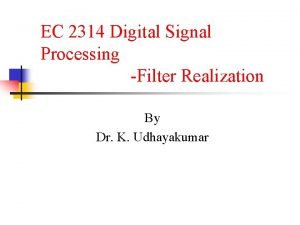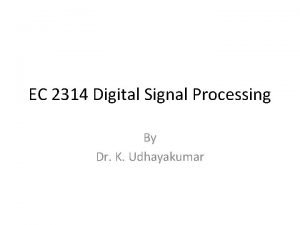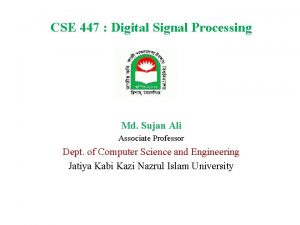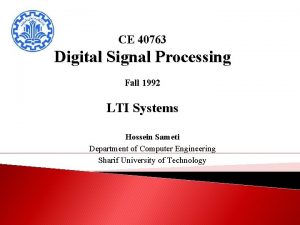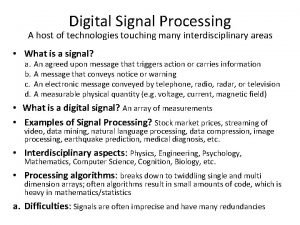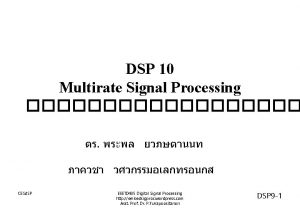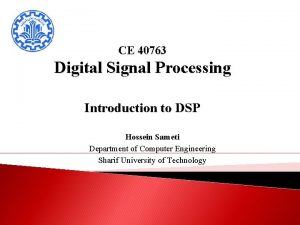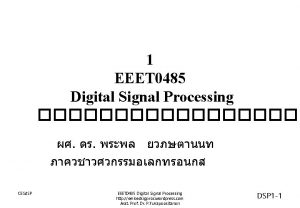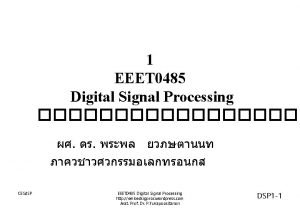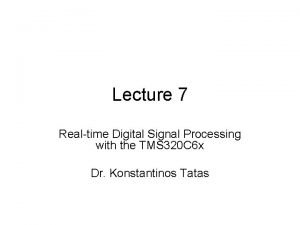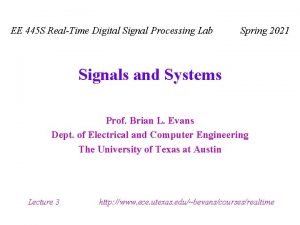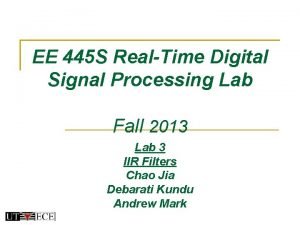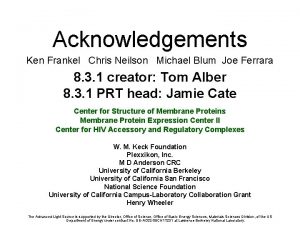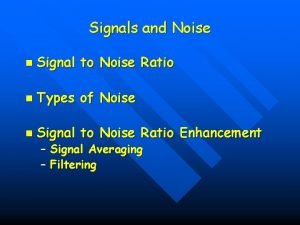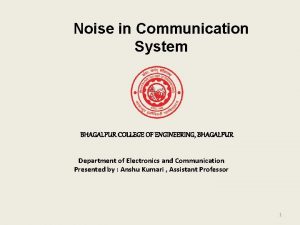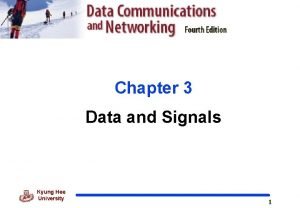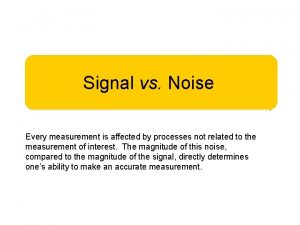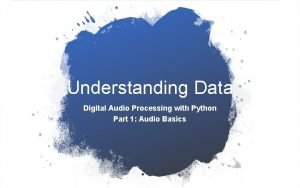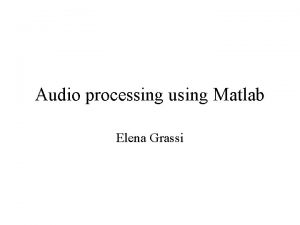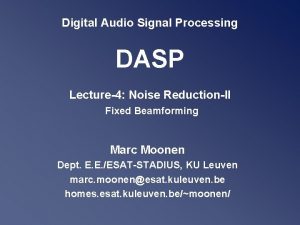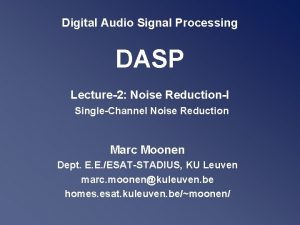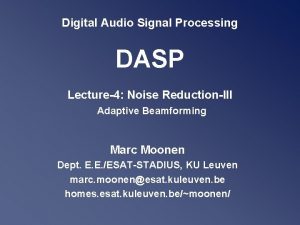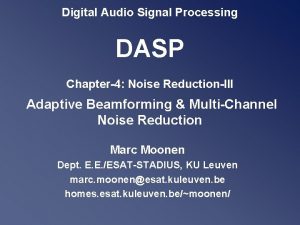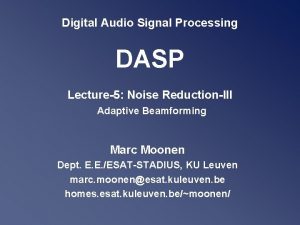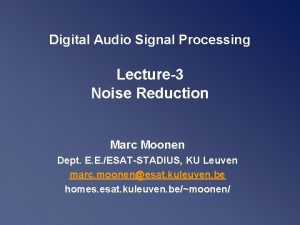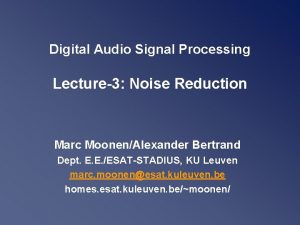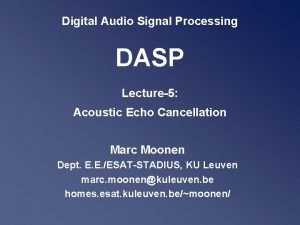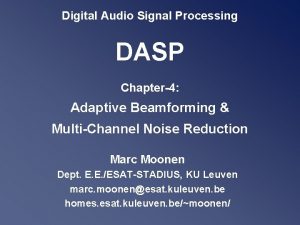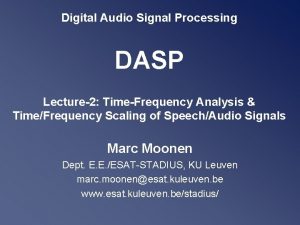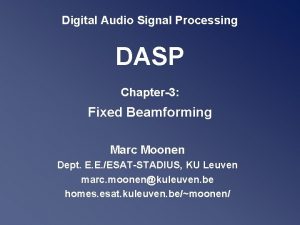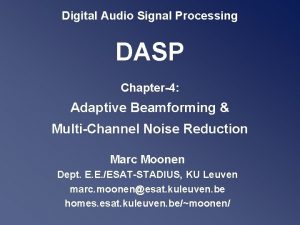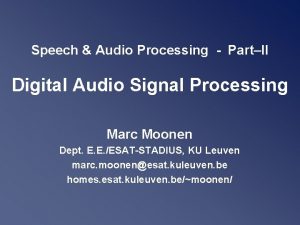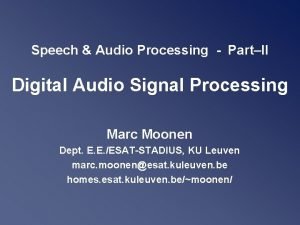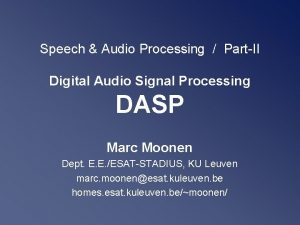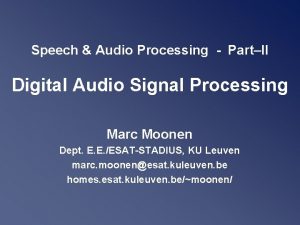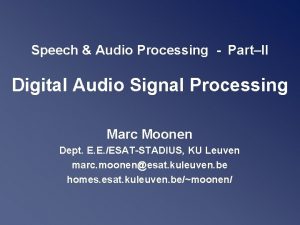Digital Audio Signal Processing DASP Lecture3 Noise ReductionII


































- Slides: 34

Digital Audio Signal Processing DASP Lecture-3: Noise Reduction-II Fixed Beamforming Marc Moonen Dept. E. E. /ESAT-STADIUS, KU Leuven marc. moonen@kuleuven. be homes. esat. kuleuven. be/~moonen/

Overview • Introduction & beamforming basics • Data model & definitions • Filter-and-sum beamformer design • Matched filtering – White noise gain maximization – Ex: Delay-and-sum beamforming • Superdirective beamforming – Directivity maximization • Directional microphones (delay-and-subtract) Digital Audio Signal Processing Version 2017 -2018 Lecture-3: Fixed Beamforming 2 / 34

Introduction • Directivity pattern of a microphone – A microphone (*) is characterized by a `directivity pattern which specifies the gain & phase shift that the microphone gives to a signal coming from a certain direction (i. e. `angle-of-arrival’) – In general the directivity pattern is a function of frequency (ω) – In a 3 D scenario `angle-of-arrival’ |H(ω, θ)| for 1 frequency is azimuth + elevation angle – Will consider only 2 D scenarios for simplicity, with one angle-of arrival (θ), hence directivity pattern is H(ω, θ) – Directivity pattern is fixed and defined by physical microphone design (*) We do digital signal prcessing, so this includes front-end filtering/A-to-D/. . Digital Audio Signal Processing Version 2017 -2018 Lecture-3: Fixed Beamforming 3 / 34

Introduction • Virtual directivity pattern – By weighting or filtering (=freq. dependent weighting) and then summing signals from different microphones, a (software controlled) virtual directivity pattern (=weigthed sum of individual patterns) can be produced + : – This assumes all microphones receive the same signals (so are all in the same position). However… Digital Audio Signal Processing Version 2017 -2018 Lecture-3: Fixed Beamforming 4 / 34

Introduction • However, in a microphone array different microphones are in different positions/locations, hence also receive different signals • Example : uniform linear array i. e. microphones placed on a line & uniform inter-micr. distances (d) & ideal micr. characteristics (p. 10) + : For a far-field source signal (i. e. plane wave), each microphone receives the same signal, up to an angle-dependent delay… fs=sampling rate c=propagation speed Digital Audio Signal Processing Version 2017 -2018 Lecture-3: Fixed Beamforming 5 / 34

Introduction • Beamforming = `spatial filtering’ based on microphone characteristics (directivity patterns) AND microphone array configuration (`spatial sampling’) + : • Classification: Fixed beamforming: data-independent, fixed filters Fm e. g. delay-and-sum, filter-and-sum =This lecture Adaptive beamforming: data-dependent filters Fm e. g. LCMV-beamformer, generalized sidelobe canceler =Next lecture Digital Audio Signal Processing Version 2017 -2018 Lecture-3: Fixed Beamforming 6 / 34

Introduction • Background/history: ideas borrowed from antenna array design and processing for radar & (later) wireless communications • Microphone array processing considerably more difficult than antenna array processing: – narrowband radio signals versus broadband audio signals – far-field (plane waves) versus near-field (spherical waves) – pure-delay environment versus multi-path environment • Applications: voice controlled systems (e. g. Xbox Kinect), speech communication systems, hearing aids, … Digital Audio Signal Processing Version 2017 -2018 Lecture-3: Fixed Beamforming 7 / 34

Overview • Introduction & beamforming basics • Data model & definitions • Filter-and-sum beamformer design • Matched filtering – White noise gain maximization – Ex: Delay-and-sum beamforming • Superdirective beamforming – Directivity maximization • Directional microphones (delay-and-subtract) Digital Audio Signal Processing Version 2017 -2018 Lecture-3: Fixed Beamforming 8 / 34

Data model & definitions 1/5 Data model: source signal in far-field (see p. 14 for near-field) • Microphone signals are filtered versions of source signal S( ) at angle • Stack all microphone signals (m=1. . M) in a vector d is `steering vector’ • Output signal after `filter-and-sum’ is Digital Audio Signal Processing Version 2017 -2018 H instead of T for convenience (**) Lecture-3: Fixed Beamforming 9 / 34

Data model & definitions 2/5 Data model: source signal in far-field • If all microphones have the same directivity pattern Ho(ω, θ), steering vector can be factored as… microphone-1 is used as a reference (=arbitrary) • Will often consider arrays with ideal omni-directional microphones : Ho(ω, θ)=1 Example : uniform linear array, see p. 5 • Will use microphone-1 as reference (e. g. defining input SNR): Digital Audio Signal Processing Version 2017 -2018 Lecture-3: Fixed Beamforming 10 / 34

Data model & definitions 3/5 Definitions: (1) • In a linear array (p. 5) : =90 o=broadside direction = 0 o =end-fire direction • Array directivity pattern (compare to p. 3) = `transfer function’ for source at angle ( -π< < π ) • Steering direction = angle with maximum amplification (for 1 freq. ) • Beamwidth (BW) = region around max with amplification > (max. amplif - 3 d. B) Digital Audio Signal Processing Version 2017 -2018 Lecture-3: Fixed Beamforming (for 1 freq. ) 11 / 34

Data model & definitions 4/5 Data model: source signal + noise • Microphone signals are corrupted by additive noise • Define noise correlation matrix as • Will assume noise field is homogeneous, i. e. all diagonal elements of noise correlation matrix are equal : • Then noise coherence matrix is Digital Audio Signal Processing Version 2017 -2018 Lecture-3: Fixed Beamforming 12 / 34

Data model & definitions 5/5 Definitions: (2) • Array Gain = improvement in SNR for source at angle ( -π< < π ) |signal transfer function|^2 (with micr-1 used as reference: d 1 =1) |noise transfer function|^2 • White Noise Gain =array gain for spatially uncorrelated noise (e. g. sensor noise) ps: often used as a measure for robustness • Directivity =array gain for diffuse noise (=coming from all directions) skip this formula PS: ω is rad/sample ( -Π≤ω≤Π ) ω fs is rad/sec DI and WNG evaluated at max is often used as a performance criterion Digital Audio Signal Processing Version 2017 -2018 Lecture-3: Fixed Beamforming 13 / 34

PS: Near-field beamforming • Far-field assumptions not valid for sources close to microphone array – spherical waves instead of plane waves – include attenuation of signals – 2 coordinates , r (=position q) instead of 1 coordinate (in 2 D case) • Different steering vector (e. g. with Hm(ω, θ)=1 m=1. . M) : e e=1 (3 D)… 2 (2 D) with q position of source pref position of reference microphone pm position of mth microphone Digital Audio Signal Processing Version 2017 -2018 Lecture-3: Fixed Beamforming 14 / 34

PS: Multipath propagation • In a multipath scenario, acoustic waves are reflected against walls, objects, etc. . • Every reflection may be treated as a separate source (near-field or far-field) • A more realistic data model is then. . with q position of source and Hm(ω, q), complete transfer function from source position to m-the microphone (incl. micr. characteristic, position, and multipath propagation) `Beamforming’ aspect vanishes here, see also Lecture-5 (`multi-channel noise reduction’) Digital Audio Signal Processing Version 2017 -2018 Lecture-3: Fixed Beamforming 15 / 34

Overview • Introduction & beamforming basics • Data model & definitions • Filter-and-sum beamformer design • Matched filtering – White noise gain maximization – Ex: Delay-and-sum beamforming • Superdirective beamforming – Directivity maximization • Directional microphones (delay-and-subtract) Digital Audio Signal Processing Version 2017 -2018 Lecture-3: Fixed Beamforming 16 / 34

Filter-and-sum beamformer design • Basic: procedure based on page 11 Array directivity pattern to be matched to given (desired) pattern over frequency/angle range of interest • Non-linear optimization for FIR filter design (=ignore phase response) • Quadratic optimization for FIR filter design (=co-design phase response) Digital Audio Signal Processing Version 2017 -2018 Lecture-3: Fixed Beamforming 17 / 34

Filter-and-sum beamformer design • Quadratic optimization for FIR filter design (continued) Kronecker product With optimal solution is Digital Audio Signal Processing Version 2017 -2018 Lecture-3: Fixed Beamforming 18 / 34

Filter-and-sum beamformer design • Design example M=8 Logarithmic array N=50 fs=8 k. Hz Digital Audio Signal Processing Version 2017 -2018 Lecture-3: Fixed Beamforming 19 / 34

Overview • Introduction & beamforming basics • Data model & definitions • Filter-and-sum beamformer design • Matched filtering – White noise gain maximization – Ex: Delay-and-sum beamforming • Superdirective beamforming – Directivity maximization • Directional microphones (delay-and-subtract) Digital Audio Signal Processing Version 2017 -2018 Lecture-3: Fixed Beamforming 20 / 34

Matched filtering: WNG maximization • Basic: procedure based on page 13 • Maximize White Noise Gain (WNG) for given steering angle ψ • A priori knowledge/assumptions: – angle-of-arrival ψ of desired signal + corresponding steering vector – noise scenario = white Digital Audio Signal Processing Version 2017 -2018 Lecture-3: Fixed Beamforming 21 / 34

Matched filtering: WNG maximization • Maximization in is equivalent to minimization of noise output power (under white input noise), subject to unit response for steering angle (**) • Optimal solution (`matched filter’) is • [FIR approximation] Digital Audio Signal Processing Version 2017 -2018 Lecture-3: Fixed Beamforming 22 / 34

Matched filtering example: Delay-and-sum • Basic: Microphone signals are delayed and then summed together • Fractional delays implemented with truncated interpolation filters (=FIR) • Consider array with ideal omni-directional micr’s Then array can be steered to angle : Hence (for ideal omni-dir. micr. ’s) this is matched filter solution Digital Audio Signal Processing Version 2017 -2018 Lecture-3: Fixed Beamforming 23 / 34

Matched filtering example: Delay-and-sum ideal omni-dir. micr. ’s • Array directivity pattern H(ω, θ): =destructive interference =constructive interference • White noise gain : (independent of ω) For ideal omni-dir. micr. array, delay-and-sum beamformer provides WNG equal to M for all freqs (in the direction of steering angle ψ). Digital Audio Signal Processing Version 2017 -2018 Lecture-3: Fixed Beamforming 24 / 34

Matched filtering example: Delay-and-sum ideal omni-dir. micr. ’s • Array directivity pattern H( , ) for uniform linear array: M=5 microphones d=3 cm inter-microphone distance =60 steering angle fs=16 k. Hz sampling frequency H( , ) has sinc-like shape and is frequency-dependent =endfire Digital Audio Signal Processing wavelength=4 cm Version 2017 -2018 =60 Lecture-3: Fixed Beamforming 25 / 34

Matched filtering example: Delay-and-sum ideal omni-dir. micr. ’s For an ambiguity, called spatial aliasing, occurs. This is analogous to time-domain aliasing where now the spatial sampling (=d) is too large. Aliasing does not occur (for any ) if M=5, =60 , fs=16 k. Hz, d=8 cm Digital Audio Signal Processing Version 2017 -2018 Lecture-3: Fixed Beamforming 26 / 34

Matched filtering example: Delay-and-sum ideal omni-dir. micr. ’s • Beamwidth for a uniform linear array: with e. g. =1/sqrt(2) (-3 d. B) hence large dependence on # microphones, distance (compare p. 24 & 25) and frequency (e. g. BW infinitely large at DC) • Array topologies: – Uniformly spaced arrays – Nested (logarithmic) arrays (small d for high , large d for small ) – 2 D- (planar) / 3 D-arrays Digital Audio Signal Processing Version 2017 -2018 Lecture-3: Fixed Beamforming 27 / 34

Overview • Introduction & beamforming basics • Data model & definitions • Filter-and-sum beamformer design • Matched filtering – White noise gain maximization – Ex: Delay-and-sum beamforming • Superdirective beamforming – Directivity maximization • Directional microphones (delay-and-subtract) Digital Audio Signal Processing Version 2017 -2018 Lecture-3: Fixed Beamforming 28 / 34

Super-directive beamforming : DI maximization • Basic: procedure based on page 13 • Maximize Directivity (DI) for given steering angle ψ • A priori knowledge/assumptions: – angle-of-arrival ψ of desired signal + corresponding steering vector – noise scenario = diffuse Digital Audio Signal Processing Version 2017 -2018 Lecture-3: Fixed Beamforming 29 / 34

Super-directive beamforming : DI maximization • Maximization in is equivalent to minimization of noise output power (under diffuse input noise), subject to unit response for steering angle (**) • Optimal solution is • [FIR approximation] Digital Audio Signal Processing Version 2017 -2018 Lecture-3: Fixed Beamforming 30 / 34

Super-directive beamforming : DI maximization ideal omni-dir. micr. ’s • Directivity patterns for end-fire steering (ψ=0): M=5 d=3 cm fs=16 k. Hz Superdirective beamformer has highest DI, but very poor WNG (at low frequencies, where diffuse noise coherence matrix becomes ill-conditioned) hence problems with robustness (e. g. sensor noise) ! DI=M 2=25 WNG=M= 5 DI=WNG=5 PS: diffuse noise ≈ white noise for high frequencies (cfr. ω Π and c/fs=λmin/2≈min(dj-di) in diffuse noise coherence matrix) Digital Audio Signal Processing obtained Version Lecture-3: Beamforming Maximum directivity=M. M for 2017 -2018 end-fire steering and for. Fixed frequency->0 (no proof) 31 / 34

Overview • Introduction & beamforming basics • Data model & definitions • Filter-and-sum beamformer design • Matched filtering – White noise gain maximization – Ex: Delay-and-sum beamforming • Superdirective beamforming – Directivity maximization • Directional microphones (delay-and-subtract) Digital Audio Signal Processing Version 2017 -2018 Lecture-3: Fixed Beamforming 32 / 34

Differential microphones : Delay-and-subtract • First-order differential microphone = directional microphone 2 closely spaced microphones, where one microphone signal is delayed (=hardware) and then subtracted from the other micropone signal d/c << , << • Array directivity pattern: – First-order high-pass frequency dependence – P( ) = freq. independent (!) directional response – 0 1 1 : P( ) is scaled cosine, shifted up with 1 such that max = 0 o (=end-fire) and P( max )=1 Digital Audio Signal Processing Version 2017 -2018 Lecture-3: Fixed Beamforming 33 / 34

Differential microphones : Delay-and-subtract • Types: dipole, cardioid, hypercardioid, supercardioid (HJ 84) =broadside =endfire Dipole: Hypercardioid: Supercardioid: Cardioid: 1= 0 ( =0) 1= 0. 25 1= 0. 5 zero at 90 o DI=4. 8 d. B Digital Audio Signal Processing zero at 109 o highest DI=6. 0 d. B Version 2017 -2018 zero at 125 o, DI=5. 7 d. B highest front-to-back ratio Lecture-3: Fixed Beamforming zero at 180 o DI=4. 8 d. B 34 / 34
 Digital signal as a composite analog signal
Digital signal as a composite analog signal Ec2314 digital signal processing
Ec2314 digital signal processing Types of signals
Types of signals Jatiya kabi kazi nazrul islam university logo
Jatiya kabi kazi nazrul islam university logo Digital signal processing
Digital signal processing Complex wave
Complex wave Digital signal processing
Digital signal processing Digital signal processing
Digital signal processing Image processing
Image processing Digital signal processing
Digital signal processing What is digital signal processing
What is digital signal processing Digital signal processing
Digital signal processing Time reversal property of z transform
Time reversal property of z transform High-performance digital signal processing
High-performance digital signal processing Digital signal processing
Digital signal processing Signal encoding schemes
Signal encoding schemes Companding quantization
Companding quantization Histogram processing in digital image processing
Histogram processing in digital image processing Unsharp masking matlab
Unsharp masking matlab Nonlinear image processing
Nonlinear image processing What is point processing in digital image processing
What is point processing in digital image processing Fractal image
Fractal image Morphological processing in digital image processing
Morphological processing in digital image processing Dr michael frankel
Dr michael frankel S/n ratio
S/n ratio Noise is added to a signal in a communication system *
Noise is added to a signal in a communication system * Baseband and broadband transmission
Baseband and broadband transmission Snr signal to noise ratio
Snr signal to noise ratio Snr signal to noise ratio
Snr signal to noise ratio Snr signal to noise ratio
Snr signal to noise ratio Signal vs noise
Signal vs noise Scipy audio processing
Scipy audio processing Elena grassi
Elena grassi Baseband signal and bandpass signal
Baseband signal and bandpass signal Baseband signal and bandpass signal
Baseband signal and bandpass signal

